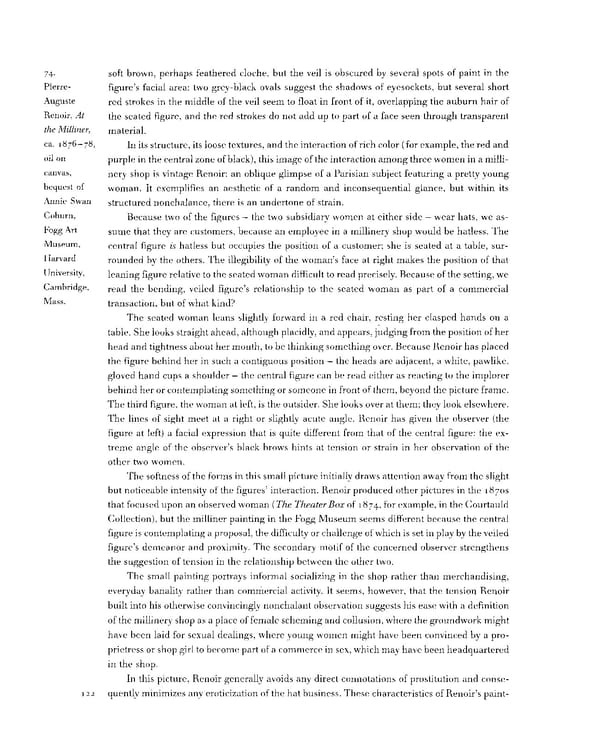74• soft brown, perhaps feathered cloche, but the veil is obscured by several spots of paint in the Pierre- figure's facial area: two grey-black ovals suggest the shadows of eyesockets, but several short Auguste red strokes in the middle of the veil seem to float in front of it, overlapping the auburn hair of Renoir, At the seated figure, and the red strokes do not add up to part of a face seen through transparent the Milliner, material. ca. 1876-78, In its structure, its loose textures, and the interaction of rich color (for example, the red and oil on purple in the central zone of black), this image of the interaction among three women in a milli- canvas, nery shop is vintage Renoir: an oblique glimpse of a Parisian subject featuring a pretty young bequest of woman. It exemplifies an aesthetic of a random and inconsequential glance, but within its Annie Swan structured nonchalance, there is an undertone of strain. Coburn, Because two of the figures — the two subsidiary women at either side — wear hats, we as- Fogg Art sume that they are customers, because an employee in a millinery shop would be hatless. The Museum, central figure is hatless but occupies the position of a customer; she is seated at a table, sur- Harvard rounded by the others. The illegibility of the woman's face at right makes the position of that University, leaning figure relative to the seated woman difficult to read precisely. Because of the setting, we Cambridge, read the bending, veiled figure's relationship to the seated woman as part of a commercial Mass. transaction, but of what kind? The seated woman leans slightly forward in a red chair, resting her clasped hands on a table. She looks straight ahead, although placidly, and appears, judging from the position of her head and tightness about her mouth, to be thinking something over. Because Renoir has placed the figure behind her in such a contiguous position — the heads are adjacent, a white, pawlike, gloved hand cups a shoulder — the central figure can be read either as reacting to the implorer behind her or contemplating something or someone in front of them, beyond the picture frame. The third figure, the woman at left, is the outsider. She looks over at them; they look elsewhere. The lines of sight meet at a right or slightly acute angle. Renoir has given the observer (the figure at left) a facial expression that is quite different from that of the central figure: the ex- treme angle of the observer's black brows hints at tension or strain in her observation of the other two women. The softness of the forms in this small picture initially draws attention away from the slight but noticeable intensity of the figures' interaction. Renoir produced other pictures in the 18708 that focused upon an observed woman (The Theater Box of 1874, for example, in the Courtauld Collection), but the milliner painting in the Fogg Museum seems different because the central figure is contemplating a proposal, the difficulty or challenge of which is set in play by the veiled figure's demeanor and proximity. The secondary motif of the concerned observer strengthens the suggestion of tension in the relationship between the other two. The small painting portrays informal socializing in the shop rather than merchandising, everyday banality rather than commercial activity. It seems, however, that the tension Renoir built into his otherwise convincingly nonchalant observation suggests his ease with a definition of the millinery shop as a place of female scheming and collusion, where the groundwork might have been laid for sexual dealings, where young women might have been convinced by a pro- prietress or shop girl to become part of a commerce in sex, which may have been headquartered in the shop. In this picture, Renoir generally avoids any direct connotations of prostitution and conse- 122 quently minimizes any eroticization of the hat business. These characteristics of Renoir's paint-
 Prostitution & Impressionists Page 142 Page 144
Prostitution & Impressionists Page 142 Page 144